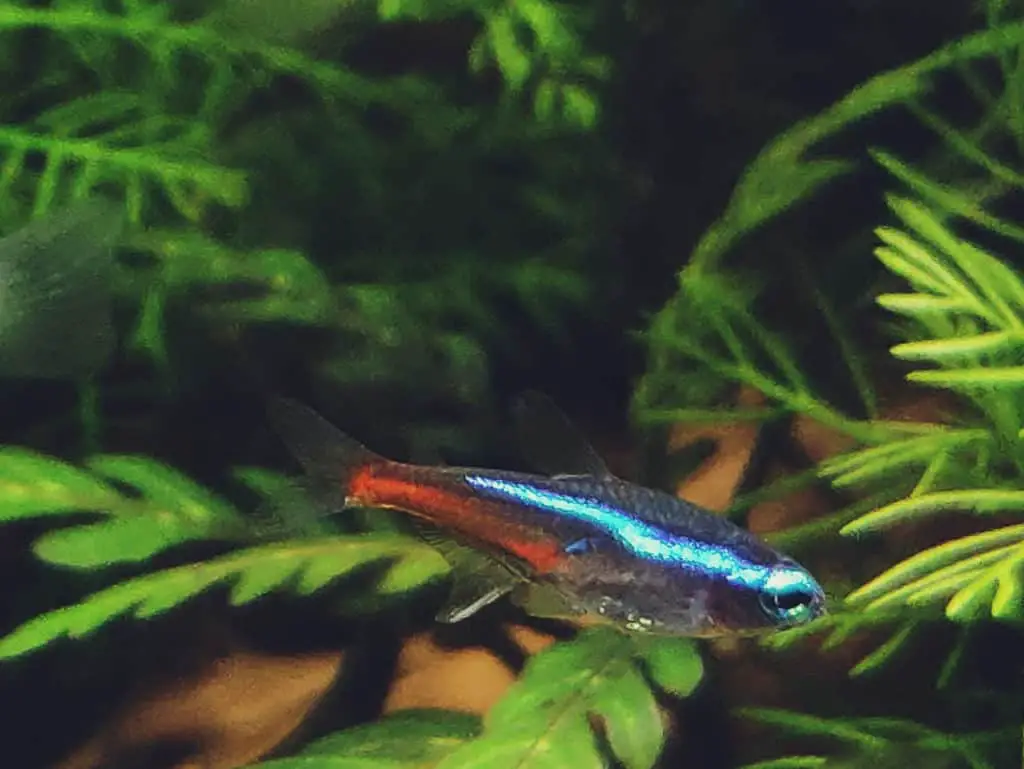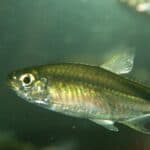You have probably seen tons of Neon Tetras in your life, but do you know that they have a beautiful green cousin? Today we will explore the stunning Green Neon Tetra. As a seasoned aquascaper and fish keeper, I will guide you through the exploration of this relatively unknown fish species.

Species Summary
Green Neon Tetras are a difficult species to find in aquarium shops as they are almost always wild-caught. They are also more difficult to care for compared to Neon Tetras and Cardinal Tetras because of their sensitiveness. The green color on their scales seems to be caused by a parasite that stimulates the deposit of guanine.
Green Neon Tetras are found mostly in the Rio Negro, Brazil, but also in the Rio Branco and the Rio Orinoco, between Venezuela and Colombia. They live in dark, slow-flowing water with dense vegetation that this fish uses as protection.
Care Guide
Tank Size
Green Neon Tetras need to be kept in groups of at least 8-10, as this will help them to show their best behavior. A 10-gallon tank is a minimum requirement. These species like to roam around the tank horizontally, so an in length developed tank would be the perfect choice.
Tank Mates
Green Neon Tetras are a very peaceful fish species; however, you should not keep them in normal community aquariums because of their small dimension and specific requirements in terms of water parameters.
Only a few species could cohabitate with this fish with success. The first one is small Corydoras, like Corydoras Pygmeus, as they are also a small and peaceful species that would not outcompete Green Neon Tetras for food. For the same reason, Bristlenose Plecos might work either. If you don’t like bottom dwellers you could keep them with any small and peaceful Tetra that you can find, but be careful that these could adapt to Green Neon Tetras specific (and extreme) water parameters.
Same Species Tanks
As mentioned earlier, the same species tank is the best solution for this fish. This would allow them to calmly shoal around in groups.
Water Parameters
Here comes the tricky part. As wild-caught fish, they need a tank where their natural water conditions are met. This increases the difficulty of keeping these fish, as they live in dark, acidic, ultra-soft water. The pH level of the water should be between 5.5 and 6.0, and the water hardness between 1 and 4 GH. The temperature should be kept between 73 and 80 degrees.
Pollutants should be kept as low as possible, as these fish is sensitive to bad water conditions.
What to Put in Their Tank
In nature, they live in slow-flowing rivers with dark brownish water full of tannins. Recreating their natural habitat is really important to prevent stress.
The substrate should be dark sand on gravel. Dark substrate prevents light reflections and reduces fish stress.
You should use a lot of plants and woods to recreate a natural river bottom scape. This is very important, as it will create hides for the fish, making them feel more relaxed (even if there are no actual predators in your tank). Floating plants are really important, as Green Neon Tetras prefer low lighting conditions.
To recreate the brownish water color you should use Catappa leaves on the bottom. These will both release tannins in the water column, and further improve the natural look of the tank.
Common Diseases
Green Neon Tetras are susceptible to many of the diseases that affect freshwater fish such as Ich. This parasite causes white spots to form on the body of the fish, leading to premature death.
You should perform regular water checks to ensure that the tank is at the correct temperature, PH level and nitrate level to help avoid disease. Remember that a complete diet can also help to prevent diseases in general.
As soon as you notice one of your fish is sick, move them to a quarantine tank to help stop the disease from spreading to their tank mates. Put the fish back in the main tank only when you’re sure that they are fully recovered.
Food and Diet
Green neon Tetras have an omnivorous diet. In nature they eat small invertebrates, crustaceans, string algae, fruit.
In a tank you can feed them with pellets, however, a varied diet would result in a better colouration and activity. You could integrate their diet with live or frozen food such as Chironomus, larvae, daphnia, etc.
Lifespan
Green Neon Tetras can live up to 10 years in an aquarium. However, a lot depends on the water conditions and on the diet. A clean tank, together with a complete diet will increase their lifespan considerably.
Appearance
Green Neon Tetras look like Neon Tetras except for some specific characteristics. First, Green Neon Tetras have a side strip that tends toward green instead of blue. Second, the side strip is longer, thicker, and stretches up to the eye. In addition, the red strip is smaller and less saturated.
Size
Tetras are known for small fish species, and Green Neon Tetras make no exception. This fish can hardly grow more than 1 inch long, one of the smallest Tetra in the world. Behaviour and Temperament
Green Neon Tetras are peaceful fish. They enjoy shoaling around in groups without harming other tank mates. On the other side, they could feel threatened by more active and aggressive tank mates, becoming shy and often hiding between plants and woods.
Breeding
Green Neon Tetras lay their eggs in open waters, without any parental care, and in a well set up aquarium, they reproduce regularly. However, it is much more difficult to see the fry grow, given the predation of the adults. If you want to increase the number of surviving fries, you need to set up a dedicated aquarium.
The breeding tank should be very dimly lit, filled with clumps of fine-leaved plants such as Java moss, or even mops, to give the fish a place to spawn. Alternatively, you could cover the base of the aquarium with some kind of mesh, large enough for the eggs but not for the adults. The water must be soft and acidic in the pH range 5.5-6.5, gH 1-5, with a temperature of about 80-86 degrees. A small air sponge is all that is needed in terms of filtration.
Green Neon Tetras can be reproduced in pairs or groups, but seem to prefer the latter, using a group of half a dozen of each sex.
Adults eat eggs and fry, so it is best to remove them once you notice the eggs.
The eggs hatch in 24-36 hours, and the fry reaches free swimming approximately 3-4 days later.
They should be fed an infuser-type food for the first few days until they are large enough to accept microworms and brine shrimp. Eggs and fry are sensitive to light early in life, and the aquarium should be kept in the dark if possible.
Gender Differences: Male vs. Female
Green Neon Tetra females are usually bigger and have a more rounded body than males.








